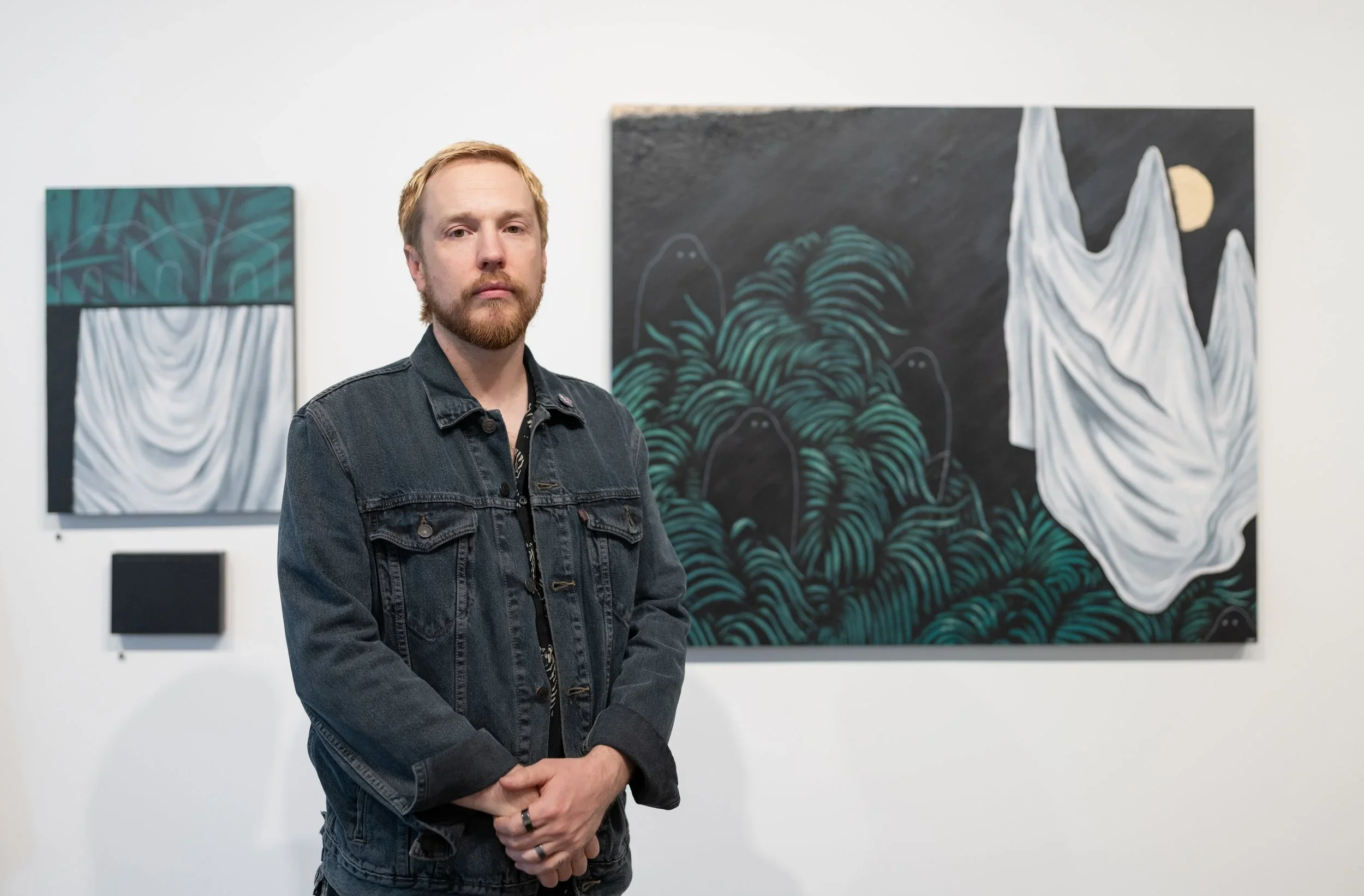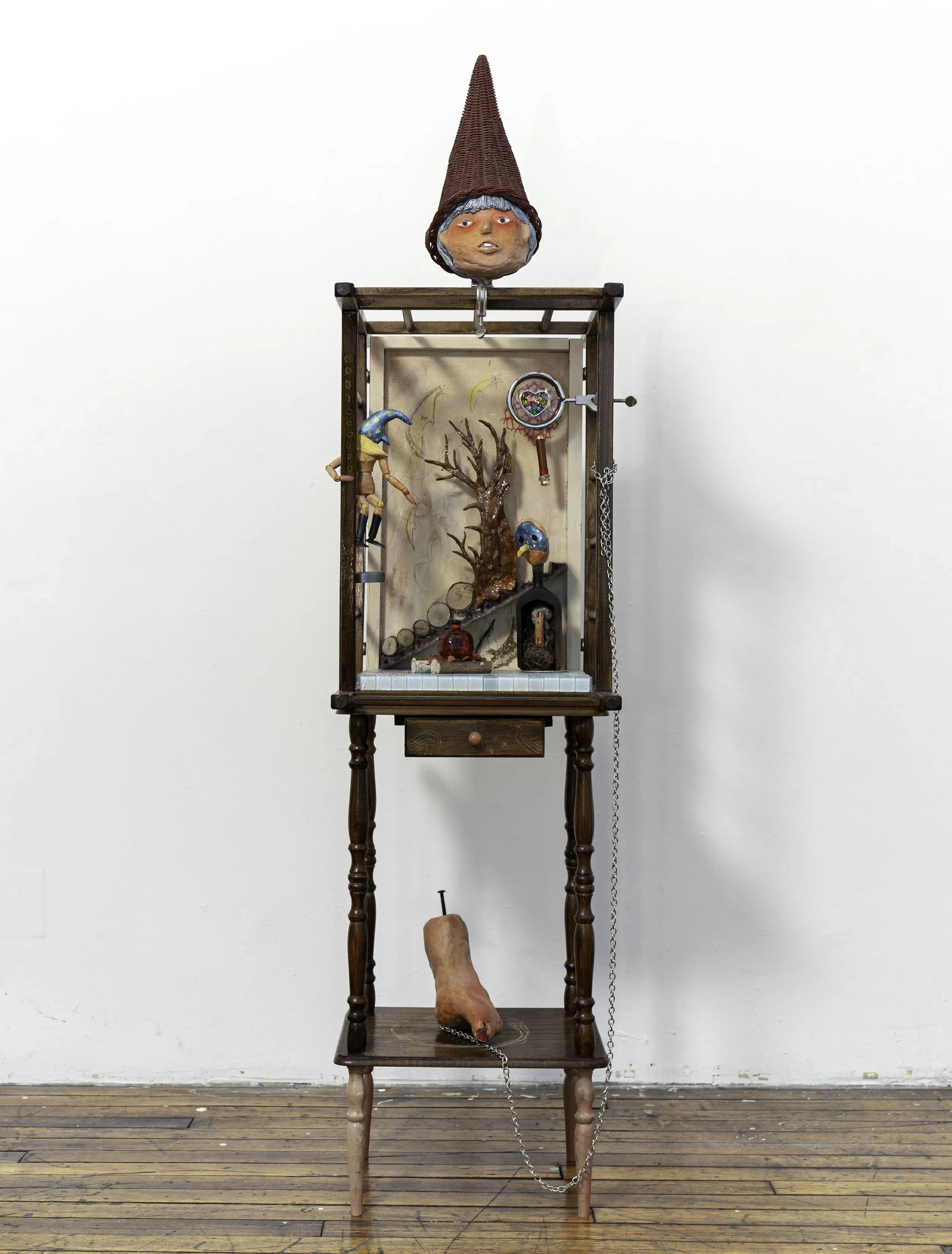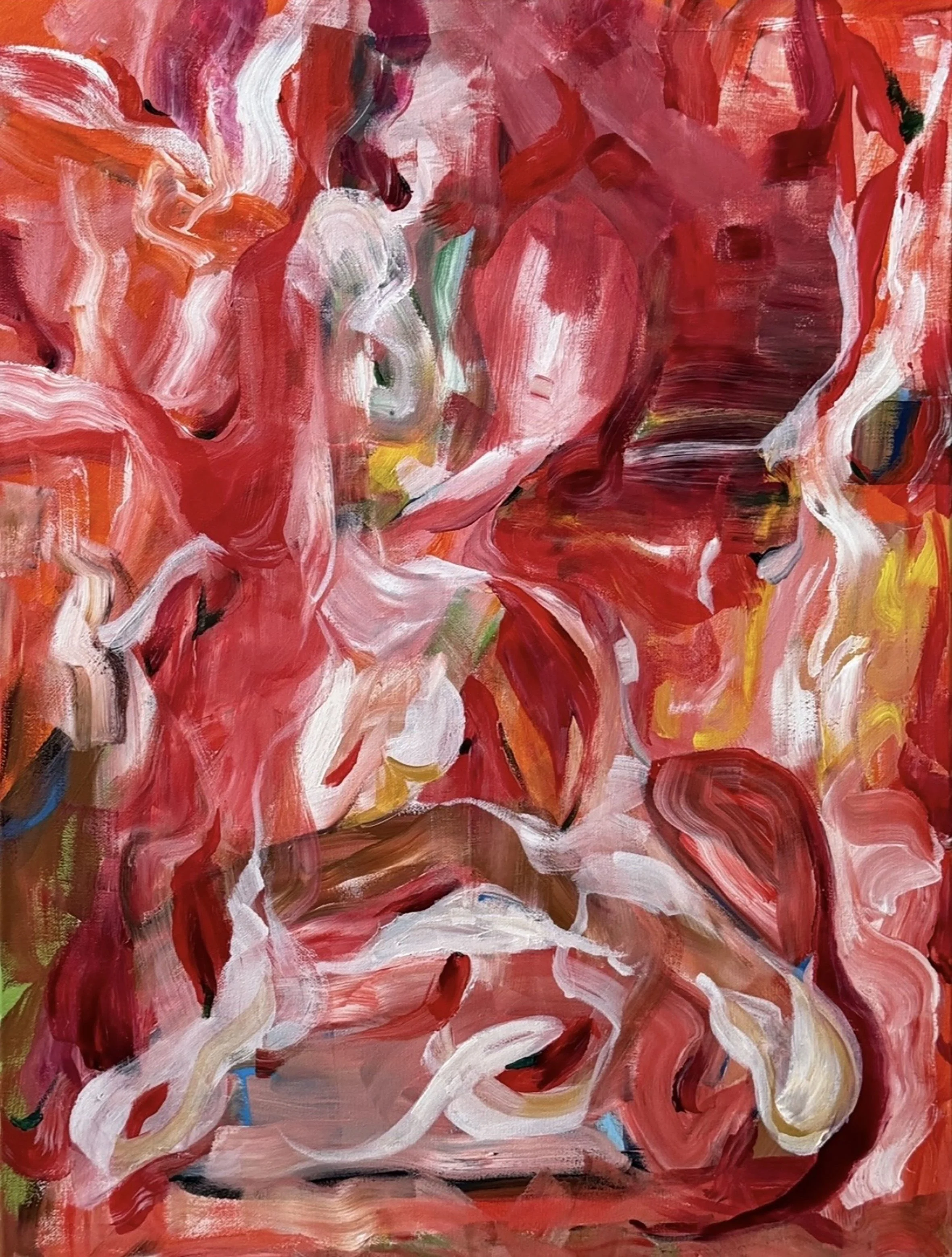10 Questions with Varvara Sosedova
Al-Tiba9 Art Magazine ISSUE14 | Featured Artist
Varvara Stern was born on November 6th, 1986, in Moscow, Russia. She received a basic art education at the Moscow State Academic Memory of 1905 Art School, completing the course “Painting” (2009), and then finished the course “Illustration” at the British Higher School of Art & Design in Moscow (2013). Since 2009, she has been studying Old Master techniques, continuing her theoretical and practical studies. Her research methodology and choice of subjects have been influenced by her interest in ancient Oriental philosophy. She examines the authenticity of art and human presence in the world and the art of the past. She works with aboriginal and other indigenous ornaments, using motifs from ancient Korean masks, symbolism, and animism from ancient religions. Varia also works with blockchain technologies to create projects in the context of the decentralized crypto-art market. She is a participant in collective exhibitions in Russia, Europe, the USA, and the UK.
Varvara Sosedova - Portrait
ARTIST STATEMENT
Varia Stern’s practice is the result of an interdisciplinary exploration of historical and contemporary phenomena. Using ancient oriental philosophical practices (e.g., animalism and tarot), she explores the human connection to the world, exposing historical and cultural parallels in history. She moves the characters in a non-linear way from the past to the present. She uses the techniques of symbolism and creates the interpenetration of different cultures by mashing them up. Varia uses glitch and phygital techniques. Through cultural and historical allusions, she expresses her respect for different cultures by representing her own interpretations of current subjects and themes through crosslinks and homages. This is how she reflects on how the norms of a social institution change over time and which remain unchanged. Varia works in the seven-layer technique of the Flemish masters of the 16th century, seeking harmony between color and subject composition.
Tarot. Queen of Cups, Oil and acrylic on canvas, 70х70 cm, 2023 © Varvara Sosedova
Tarot 2.0 | Project Statement
The Tarot 2.0 project was originally conceived as an artist's deck of cards. However, it has become a large painting project in which Varvara Stern explores the archetypes of humanity through the prism of costumes, colors, artifacts, hidden symbols, and world history. Some of the paintings have given rise to a series, like the King of Cups, which has its own story and name - Richard Babington. The artist plans to work on the Tarot series for 10-15 years to follow the changes in the world and in her art.
Tarot. The Knight of Cups, Oil and acrylic on canvas, 90x90 cm, 2023 © Varvara Sosedova
Limited edition magazine >>
INTERVIEW
First of all, let's talk about your background. Could you tell us more about yourself and how you began making art?
I was born into a family of professional musicians. Despite the fact that I started drawing before I learned to speak, my parents wanted me to become a musician. Therefore, from the age of 5 to 15, I practiced the violin professionally and was about to go to school at the Moscow Conservatory.
Although I later decided to become an artist, it helped me understand and feel music, and I fell in love with opera and ballet with all my heart. In addition to violin, I studied at a choreographic school with very serious ballet training. I was also in a strong maths class. And I still adore algebra, geometry, and physics. But I also drew all the time, a bit underground, in the margins of my notebook.
I am glad that this experience was gained at a young age. It accustomed me to daily routine labor. After all, in painting, as in music and math, it is very important to master the craft so that you don't have to think about technique when creating a painting.
When did you decide to become an artist? And what do you wish you knew about contemporary art before you got started?
At 15, I decided to become an artist. Although I had never studied drawing professionally, I prepared for a year with a teacher and entered the Moscow State School of Memory of 1905.
Department of Stationary Painting. It is a good academic training with a strong Russian school.
I am most grateful to our anatomy teacher and art history teacher. Thanks to them, I was not afraid to draw human beings, and I loved studying history. However, we are not taught anything about modern-world art. I started studying all this much later, thanks to the Internet. Later, I graduated from the British Hight School of Design, Illustration Department, where I learnt about contemporary art, and book artists. That was a big breakthrough for me.
Tarot. King of Cups #2, Oil and acrylic on canvas, 150x150 cm, 2023 © Varvara Sosedova
Tarot. King of Cups #3, Oil and acrylic on canvas, 100x100 cm, 2022 © Varvara Sosedova
Let's talk about your creative process. What is your artistic routine when working? Do you have a set schedule, or do you work following your inspiration?
The violin taught me that inspiration doesn't exist. Or rather, it comes while you're working. First, you have to play an etude 150 times, and only at the 151st time will inspiration and real freedom come to you.
Besides, I have been studying oil painting techniques of the old masters for more than 15 years: Van Eyck, Breig, Dürer, Da Vinci.
So I try to find the composition, understand the colors, think through the plot and the whole picture, and only then do I start working on canvas. When building color, only working with thin layers of paint allows me to achieve a strong-sounding color. Mostly, I paint with the thinnest layers of paint to bring out the colour to its fullest.
I like to get up early and work on several projects at the same time during the day.
Speaking of your work, in your statement, you mention how you are influenced by Oriental philosophies, aboriginal and indigenous ornaments, and traditional symbolism. How do you incorporate these elements in your work?
Like I said, I love history. So much! Not only the history of art but also of ancient civilizations, philosophy, costumes, and everyday life.
I am close to the Oriental philosophy of careful coexistence of man and nature, of beauty and contemplation.
I encrypt ornaments in clothes and hide artifacts in landscapes or in water. I have references in my work to the films of Tarkovsky and Kim Ki-duk, who have had a huge influence on me.
But I try to do it in a very subtle, unobtrusive way, not head-on. I like my paintings to reveal themselves gradually. Like that, they have their own secrets.
I find all this in the art of other countries. The subtle interweaving of human history and the world around us. I feel harmony, seasons, light/dark, seasons. And all this is put into symbols, plants, colours. In this way, we get some kind of message to which we need to find the key. It's incredibly inspiring!
Tarot. King of Pentacles, Oil and acrylic on canvas, 70x70 cm, 2023 © Varvara Sosedova
Why did you choose to work with foreign references? Do you find them stimulating, or do they convey universal messages that can be understood and implemented despite the geographical region or cultural background?
Yes, I feel they are without time and space. Like Shakespeare's plays, they tell a story of Man that everyone can understand. And I see how many common stories, similar patterns in very different cultures. It's amazing. And the more I study and compare, the more commonalities I see. I find something very important in each culture that is close to me.
For me, Kim Ki-duk's movies, Miyazaki's cartoons, Van Eyck's paintings, Shakespeare's plays, African masks, and Australian Aboriginal art are incredibly important. This is my personal cultural and human code.
How did you develop this idea, and how do you see it evolving in the future? Do you plan to continue this series?
I love symbols, mysticism, and archetypes of people. I wanted to make a series of works that were united by an idea, but at the same time, each work was self-sufficient and complete.
I like the long work on costume, landscape, details, and meanings. I also want to see this project change with me, so I plan to work on paintings for the next ten years. It's also fun to see how one of the works became the start of a separate series, even an entire world. I'm talking about Richard Babington. He has an army of fans, and I even had to make a separate account for him. So, the series has a life of its own. My job is to bring it to the world.
Tarot. Six of Cups, Oil and acrylic on canvas, 50x50 cm, 2023 © Varvara Sosedova
Tarot. Page of Cups, Oil and acrylic on canvas, 50x50 cm, 2023 © Varvara Sosedova
At the same time, you also work with advanced technologies, like Crypto art. How do you blend such different elements and keep your style cohesive?
There is nothing surprising about this. I have been painting on a graphics tablet for a long time, thinking out the layers and composition of my paintings in advance.
I equally enjoy working on the iPad and with live materials. It helps me to switch gears and not get tired of projects. The NFT world has also taught me to think in large series and projects. I also discovered a lot of very strong artists, I started to try different styles and techniques, and this has also had a big influence on my paintings.
Speaking of Crypto art and NFTs, do you still believe in this technology? Since the market crash, it seems to be less popular nowadays. Will we see a resurgence, or is it gone for good?
Yes, of course, the decline is noticeable. But I think this is a normal process for any innovative phenomenon. People who wanted a quick high and money have left. Those who work for a long time, who create, educate, do not give up, and believe in success - they continue to successfully create projects and sell their art. I always advise everyone to subscribe to the newsletter of the awesome Cozomo de Medici - Medici Minutes - it's one of the best things for understanding crypto art. I've been out of the NFT for a year myself as I've been very busy with painting and charity projects. But keeping in touch with artists and preparing an NFT project for Superrare. I can say that I believe in the NFT world, artists, and the future of crypto art.
Tarot. Queen of Cups #2 (Maria), Oil and acrylic on canvas, 60x60 cm, 2023 © Varvara Sosedova
Talking about the future, what are you working on now, and what are your plans for the future? Do you have any upcoming exhibitions or projects?
Yes, in a year's time, I will have a solo exhibition in France. Some works will go to Art Qatar and then to Art Dubai. I am preparing several chamber exhibitions in London. There are a lot of plans, and the main thing is to have time for everything. In the meantime, I am renovating my studio, and I hope I can cope with this natural disaster.
Finally, as you are still very young, where do you see your career and your art going in the future? What do you hope to accomplish in the next few years?
I want to continue to paint. I also really want to create costumes and sets for ballet.
My dream is Prokofiev's Romeo and Juliet. I also want to open a clothing brand for adults and children, open a publishing house, and create my own fund to help animals in distress. For the last year, I have been helping dogs and cats in distress, uniting volunteers - it has become a huge part of my life. Thanks to my creativity, I have been able to help dozens of animals.
As you can see, I have very ambitious plans. Painting, books, Cryptoworld, helping animals, costumes - these projects are incredibly important to me. I realize that I am only at the beginning of my journey. Let's see what adventure awaits me.
Artist’s Talk
Al-Tiba9 Interviews is a promotional platform for artists to articulate their vision and engage them with our diverse readership through a published art dialogue. The artists are interviewed by Mohamed Benhadj, the founder & curator of Al-Tiba9, to highlight their artistic careers and introduce them to the international contemporary art scene across our vast network of museums, galleries, art professionals, art dealers, collectors, and art lovers across the globe.




























